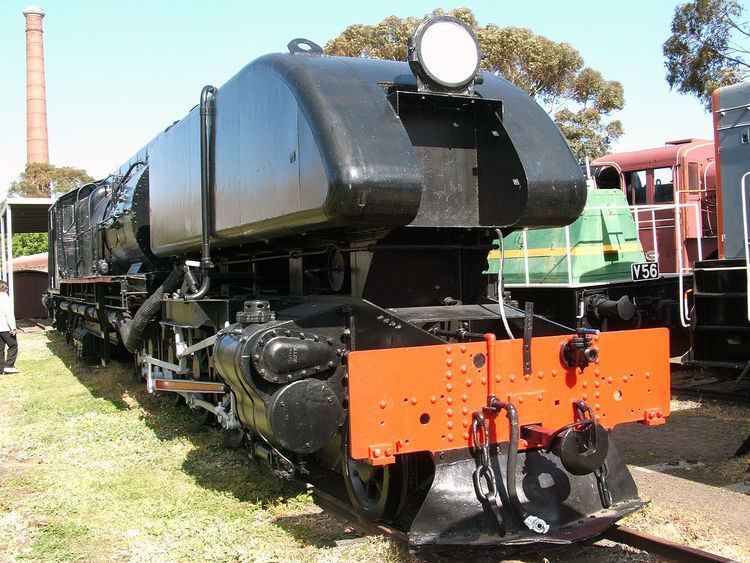Power type Steam Total produced 57 Gauge 3 ft 6 in (1,067 mm) | Build date 1943-1945 Configuration 4-8-2+2-8-4 | |
 | ||
Builder Clyde EngineeringIslington Railway WorkshopsMidland Railway WorkshopsNewport Workshops | ||
The Australian Standard Garratt (ASG) was a Garratt steam locomotive designed in Australia during World War II, and used on 3 ft 6 in (1,067 mm) narrow gauge railway systems in Queensland, South Australia, Western Australia and Tasmania.
Contents
History
With the outbreak of World War II, in 1939 the Federal Government formed the Commonwealth Land Transport Board (CLTB) to take responsibility for the country's land transport networks. It had the power to override the decisions of the State railways. In 1942, the CLTB appointed the Commissioner of Railways in Western Australia, Joseph Ellis, to investigate the capacity of Australia's narrow gauge network and recommend what locomotives should be purchased. Ellis recommended that three variations of Garratt locomotive be purchased; heavy, medium and light.
The CLTB elected to build only the light type to allow it to operate on any narrow gauge line in Australia. After an attempt to obtain drawings and licenses from Beyer, Peacock and Company failed, in July 1942 the CLTB recommended to the War Cabinet that 30 locomotives be built locally. In August 1942, the War Cabinet approved the order, this was increased to 65 locomotives in November 1942. The Western Australian Government Railways' Chief Mechanical Engineer Frederick Mills was seconded to lead a team of engineers in Melbourne to design the new locomotive. The Queensland Railways were vocal opponents, stating its preference for a modified version of its C17 class.
The result was the Australian Standard Garratt with the first completed in a record breaking four months in September 1943. Only 57 were completed with the remaining eight cancelled with the end of the war. The locomotives were built by the WAGR's Midland Railway Workshops (10), the Victorian Railways' Newport Workshops (12), the South Australian Railways' Islington Railway Workshops (13), and Clyde Engineering, Sydney (22).
In service
Because of differences between the states, especially in regard to loading gauges, the sharpness of curves, and axle load, especially in Queensland, the design had to be a compromise, which went against the idea of having a standardised design.
A major flaw in the design was that the leading driving wheels were flangeless, which caused derailments on curves and points. Another key problem, which made the locomotives unpopular with locomotive crews, was the fact that the firebox door opened flat on the floor of the driving cab, maximising heat radiation into the crew compartment. This resulted in them having fairly short lives with most withdrawn by the mid-1950s. Some were resold for use on the Emu Bay and Fyansford Cement Works Railways where they would have more successful careers.
Queensland Railways
The Queensland Railways purchased 23. One was never used and another only saw two months service. In September 1945, the driver's union placed a ban on them. Attempts to modify them proved unsuccessful and in 1948, they were written off. Three were sold to the Emu Bay Railway and six to the Tasmanian Government Railways with the remainder scrapped in 1954/55.
Tasmanian Government Railways
The Tasmanian Government Railways purchased 14 new and another six second-hand from the Queensland Railways. Two were sold to the Emu Bay Railway with the remainder scrapped in the late 1950s.
Western Australian Government Railways
The Western Australian Government Railways purchased 25. They were unpopular with crews, and their use through the state's only tunnel at Swan View caused serious problems, resulting in deaths, industrial disputes, and a Royal Commission.
Six were sold to the South Australian Railways in 1952 with the last withdrawn from the WAGR in January 1957.
Emu Bay Railway
The Emu Bay Railway purchased three second-hand from the Queensland Railways and two from the Tasmanian Government Railways. It would operate them successfully until the mid-1960s. One was destroyed in an accident in February 1962 with a replacement obtained from the TGR.
South Australian Railways
In 1952, the South Australian Railways purchased six second-hand from the WAGR to haul lead ore between Cockburn and Port Pirie as an interim solution pending the delivery of the 400 class Garratts, with all condemned by February 1956.
Fyansford Cement Works Railway
The Fyansford Cement Works Railway purchased G33 from Commonwealth Disposals in August 1945. It was withdrawn in 1957, but maintained in operational condition until the railway closed in 1966 and donated to the Geelong division of the Australian Railway Historical Society. It was on static display at the Australian Railway Historical Society Museum until May 2013, when it was relocated to the Bellarine Railway.
Preservation
The only surviving complete ASG is G33, which ran on the Fyansford Cement Works Railway until 1966. It was on static display at the Australian Railway Historical Society Museum in North Williamstown until May 2013, G33 along with a spare boiler was moved by road to the Bellarine Railway, Queenscliff.
Many front ASG water tanks have survived; one at Yatina, South Australia, and two on a farm south of Peterborough, South Australia. Two at Don River Railway in Tasmania and several dotted around the state. These survived as water tanks for steam and firefighting tanks until the early 1980s. A boiler also survives with the Derwent Valley Railway in New Norfolk, Tasmania.
